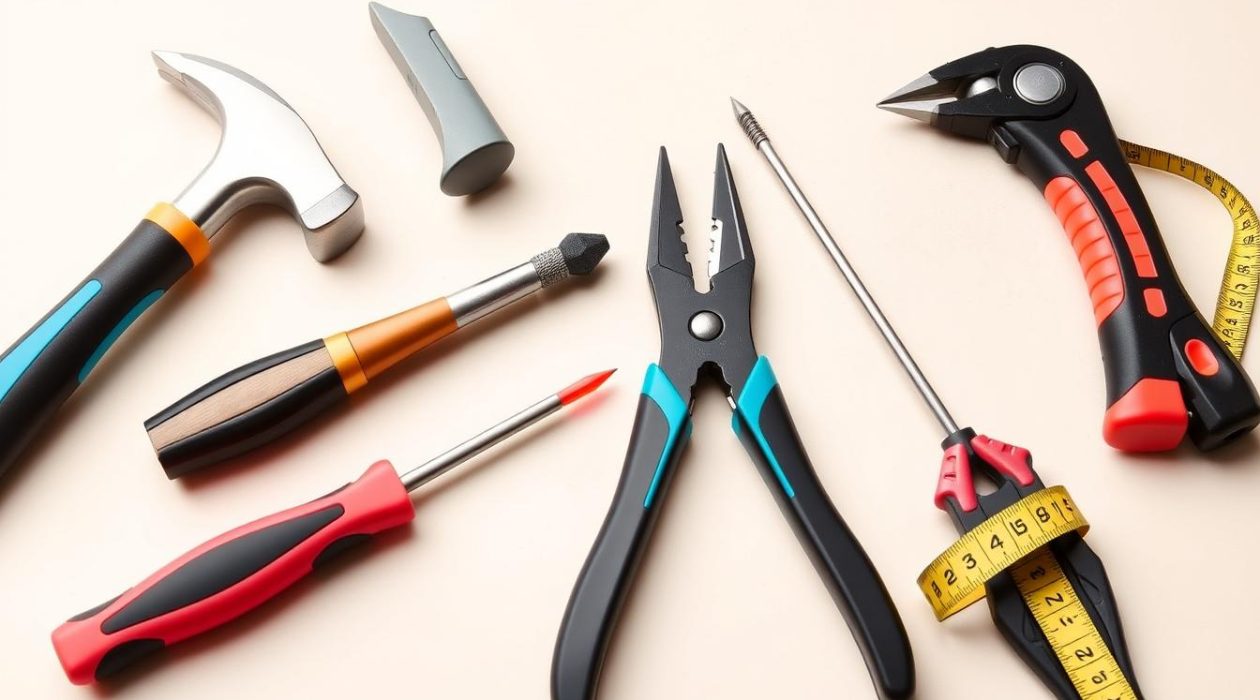Ergonomic hand tools are crafted to offer comfort, efficiency, and safety for women in various settings. They are essential for both DIY enthusiasts and professionals. These tools are designed to fit comfortably in a woman’s hand, reducing strain and enhancing performance. This is crucial for women who frequently use hand tools, as it helps prevent fatigue and injury.
Adopting ergonomic hand tools can significantly alter how women approach their work. These tools are engineered to align with a woman’s hand, minimizing discomfort. This leads to improved productivity and efficiency, alongside a lower risk of injury.
Introduction to Ergonomic Hand Tools
Ergonomic hand tools are a vital investment for women who regularly handle tools. They offer a comfortable and efficient means to accomplish tasks, aiding women in achieving their objectives. Whether you’re into DIY projects or work professionally, ergonomic hand tools are indispensable for safe and efficient work.
Key Takeaways
- Ergonomic hand tools provide comfort, efficiency, and safety for women in various tasks
- Tools for women, such as ergonomic hand tools, cater to the needs of women and provide a comfortable grip
- Ergonomic hand tools can help prevent fatigue and injury in women who use hand tools frequently
- Using ergonomic hand tools can increase productivity and efficiency
- Ergonomic hand tools are an essential investment for any woman who uses hand tools regularly
- Tools for women, such as ergonomic hand tools, are designed to fit comfortably in a woman’s hand
- Ergonomic hand tools can help women achieve their goals and complete tasks with ease
Understanding Ergonomic Tools and Their Importance
Ergonomic hand tools are crafted to alleviate fatigue and discomfort, making them perfect for women who frequently use their hands at work. These tools are designed to fit comfortably in a woman’s hand, thus reducing strain and enhancing performance. Their significance lies in their capacity to prevent injuries and lower the risk of long-term damage.
When evaluating women-friendly tools, several factors are crucial. The handle’s size and shape, the material used, and the weight distribution all impact the tool’s ergonomics. For instance, a tool with a contoured handle and balanced weight can ease the strain on the hand and wrist, facilitating prolonged use.
What Makes a Tool Ergonomic
An ergonomic tool aligns with the natural shape and movement of the human body. It should be comfortable to hold and use, with a handle that fits the hand and a balanced weight. Ergonomic hand tools, such as those for gardening or DIY projects, significantly reduce fatigue and enhance performance.
The Science Behind Tool-Related Strain
Tool-related strain occurs when the body is forced into unnatural positions, leading to fatigue and discomfort. This often happens with tools not designed with ergonomics in mind, requiring users to bend or twist. Ergonomic hand tools, designed with women in mind, aim to mitigate this strain, allowing for extended work periods without fatigue.
Benefits of Women-Specific Tool Design
The advantages of women-specific tool design are vast. Ergonomic hand tools not only reduce fatigue and discomfort but also enhance performance and accuracy. By creating tools that naturally fit a woman’s hand, manufacturers can lower injury risks and improve the work experience.
| Tool Type | Ergonomic Features | Benefits |
|---|---|---|
| Gardening Tools | Contoured handles, balanced weight distribution | Reduced fatigue, improved accuracy |
| DIY Tools | Ergonomic grips, adjustable handles | Improved comfort, reduced strain |
Essential Features of Women-Friendly Hand Tools
When it comes to tools for women, comfort and ergonomics are paramount. Women-friendly hand tools are crafted to fit comfortably in a woman’s hand, minimizing fatigue and strain. These comfortable hand tools are crucial for various tasks, from gardening to workshop projects.
A range of tools is available, including gardening tools like pruners and trowels, and workshop essentials such as hammers and screwdrivers. The design of these tools caters to women’s specific needs, featuring smaller handle sizes and lighter weights.
Some of the key features of women-friendly hand tools include:
- Ergonomic handle designs that fit comfortably in a woman’s hand
- Lightweight materials that reduce fatigue and strain
- Smaller handle sizes that are easier to grip and maneuver
These features make tools for women more accessible and user-friendly. They enable women to complete tasks with ease and confidence. By opting for comfortable hand tools, women can lower the risk of injury and enhance their DIY project experiences.
Tool manufacturers can create products that are both functional and comfortable by considering women’s needs. This includes features like cushioned grips, balanced weights, and intuitive designs. By investing in tools for women, women can tackle new projects and challenges with confidence and precision.
| Tool Type | Features |
|---|---|
| Gardening Tools | Ergonomic handles, lightweight materials, smaller handle sizes |
| Workshop Essentials | Cushioned grips, balanced weights, intuitive designs |
The Perfect Grip: Handle Designs and Materials
For ergonomic hand tools, a perfect grip is key for comfort and efficiency. Women often face the challenge of finding tools with handles that fit their hands well. Tools for women need to have handles designed with optimal sizes to reduce strain and enhance usability.
A well-designed handle significantly impacts the user experience. The handle’s size and shape should match a woman’s hand, ensuring a firm grip without causing fatigue. The choice of handle material is also critical, with rubber, foam, and wood offering different levels of comfort and durability.
- Optimal handle size: A handle that is too large or too small can cause discomfort and reduce efficiency.
- Grip material: Different materials can provide varying levels of comfort, traction, and durability.
- Weight distribution: A well-designed tool should distribute weight evenly, reducing strain on the user’s hand and wrist.
Manufacturers can create ergonomic hand tools tailored to women’s needs by considering these factors. This leads to a more comfortable and efficient user experience. Whether you’re a professional or a DIY enthusiast, using tools for women can significantly enhance your work.
| Handle Material | Comfort Level | Durability |
|---|---|---|
| Rubber | High | Medium |
| Foam | Medium | Low |
| Wood | Low | High |
Must-Have Garden Tools for Women DIYers
Gardening is a fun and rewarding hobby, but it can be challenging without the right tools. Women-friendly tools are designed to make gardening tasks easier and more enjoyable. Having the right tools can make all the difference in gardening. Comfortable hand tools, such as pruning shears and trowels, can help reduce fatigue and strain.
Pruning and Trimming Equipment
Pruning and trimming are essential tasks in gardening. Women-friendly tools, such as pruning shears with ergonomic handles, can make these tasks more comfortable and efficient. Some must-have pruning and trimming equipment includes:
- Pruning shears with curved blades
- Long-handled pruning loppers
- Trimming scissors with comfortable grips
Digging and Planting Tools
Digging and planting are other crucial tasks in gardening. Comfortable hand tools, such as trowels and cultivators, can help reduce strain and fatigue. Some must-have digging and planting tools include:
- Trowels with ergonomic handles
- Cultivators with comfortable grips
- Planting forks with curved blades
Watering and Maintenance Equipment
Watering and maintenance are essential tasks in gardening. Women-friendly tools, such as watering cans with comfortable handles, can make these tasks more enjoyable and efficient. Some must-have watering and maintenance equipment includes:
- Watering cans with ergonomic handles
- Garden hoses with comfortable nozzles
- Maintenance gloves with grip palms
Power Tools Reimagined: Ergonomic Alternatives
Women often face challenges with power tools due to their smaller hands and lower grip strength. Yet, ergonomic hand tools have been developed to address these issues. Tools for women come with features like reduced vibration, better grip, and enhanced safety. These make them perfect for various tasks.
Examples of power tools reimagined with ergonomic design include drills, saws, and sanders. They are crafted to fit comfortably in a woman’s hand, reducing fatigue and strain. They also have adjustable handles and grips for a customized fit.
Choosing tools for women with ergonomic hand tools in mind offers a more comfortable and efficient work experience. They are ideal for both DIY projects and professional use. These tools help reduce fatigue and improve performance. With their unique features, ergonomic hand tools are a great choice for any woman aiming to enhance her work.
Workshop Essentials: From Hammers to Wrenches
A well-equipped workshop is crucial for both DIY enthusiasts and professionals. The focus on women-friendly tools aims to create a comfortable and efficient workspace. This involves investing in comfortable hand tools that reduce fatigue and boost productivity.
The basic tool kit includes hammers, wrenches, pliers, and screwdrivers. These are essential for various tasks. Specialty tools, like ergonomic grips and handles, also enhance comfort and usability.
Basic Tool Kit Components
- Hammers
- Wrenches
- Pliers
- Screwdrivers
Storage and organization are key in a workshop. A tool chest or cabinet, along with wall-mounted hooks and bins, is vital. A tidy workshop allows for more efficient and effective work.
Specialty Tools Worth Investing In
Specialty tools, like ergonomic grips and handles, are worth the investment. Tools designed for women, such as women-friendly tools with smaller handles and lighter weights, also enhance comfort. These tools make the workspace more efficient and comfortable.
| Tool | Description |
|---|---|
| Hammers | Used for driving nails and fitting parts together |
| Wrenches | Used for tightening and loosening bolts and nuts |
| Pliers | Used for gripping and bending objects |
Preventing Fatigue and Injury Through Proper Tool Selection
Using ergonomic hand tools is key to avoiding fatigue and injury. Many women face back strain and hand fatigue from poorly designed tools. It’s vital to pick tools for women that focus on ergonomics.
A tool designed with ergonomics in mind can significantly reduce injury risk. For example, a tool with a comfortable grip and balanced weight reduces hand and wrist strain. Tools with adjustable handles fit individual hand sizes, offering a secure grip and lowering accident risk.
Common Pain Points and Solutions
- Back strain: Caused by heavy or poorly balanced tools, this can be alleviated by choosing tools with ergonomic designs and balanced weight distribution.
- Hand fatigue: Resulting from tools with uncomfortable grips or excessive vibration, this can be prevented by selecting tools with cushioned grips and vibration-reducing technology.
By selecting the right ergonomic hand tools and adhering to best practices, women can lower fatigue and injury risks. This includes regular breaks, maintaining proper posture, and storing tools properly when not in use.
Best Practices for Extended Use
Following best practices for extended tool use is crucial for safety and efficiency. This includes regular tool maintenance, proper storage, and breaks to rest hands and wrists. By prioritizing tool selection and user safety, women can enjoy a more comfortable and productive experience with their tools for women.
Top Brands Creating Tools for Women
Several brands are now focusing on creating women-friendly tools that cater to their specific needs. They take into account ergonomic design and comfort. These brands recognize the importance of providing comfortable hand tools that reduce fatigue and injury.
Some of the top brands in this niche include Fiskars, Corona, and DeWit. These brands offer a range of products, from pruning and trimming equipment to digging and planting tools. All are designed with women in mind.
For example, Fiskars offers a line of women-friendly tools with ergonomic handles and balanced weight distribution. This makes them ideal for extended use. Corona, on the other hand, provides a range of comfortable hand tools with cushioned grips and shock-absorbing materials.
When choosing the right tools, it’s essential to consider factors such as handle size, grip material, and weight distribution. By selecting women-friendly tools that meet these criteria, women can enjoy a more comfortable and efficient gardening or DIY experience.
- Fiskars: Offers a range of ergonomic tools with balanced weight distribution
- Corona: Provides cushioned grips and shock-absorbing materials for reduced fatigue
- DeWit: Designs tools with ergonomic handles and comfortable grip sizes
Making the Switch: Transitioning to Ergonomic Tools
Switching to ergonomic hand tools can transform the way women use hand tools. Begin by evaluating your current tools. Look at how often you use them, their comfort, and their performance.
When upgrading to ergonomic alternatives, explore budget-friendly options. Consider buying second-hand or searching for discounts. Also, investing in multi-purpose tools can save money. Some great choices include:
- Combination pliers and wrenches
- Multi-bit screwdrivers
- Adjustable wrenches
Choosing tools for women designed with ergonomics in mind can lessen fatigue and enhance performance. Focus on comfort and functionality when picking new tools. Don’t hesitate to try various options to find the perfect match for your needs.
With careful planning and research, you can build a toolkit that meets your specific needs. This will make any project easier to handle.
| Tool Type | Ergonomic Features |
|---|---|
| Hammer | Contoured grip, balanced weight |
| Pliers | Comfortable handle, easy-grip jaws |
| Screwdriver | Ergonomic handle, magnetic tip |
Maintenance Tips for Long-Lasting Performance
To ensure your women-friendly tools remain in top condition, regular maintenance is crucial. This involves cleaning and storing them correctly, as well as checking for wear and tear. By adhering to these straightforward tips, you can prolong the life of your tools. This ensures they continue to function optimally.
Cleaning your tools effectively prevents rust and corrosion. Utilize a soft cloth and mild soap for cleaning. Ensure they are thoroughly dried afterward. For tools with moving parts, a small amount of lubricant will keep them operating smoothly.
Cleaning and Storage Guidelines
- Store tools in a dry, secure location to prevent damage and loss.
- Use a toolbox or storage container to keep tools organized and easy to find.
- Clean tools regularly to prevent rust and corrosion.
When to Replace Your Tools
Tools will eventually require replacement, even with diligent maintenance. Look out for signs of wear, such as rust, corrosion, or damaged handles. If your tools are no longer performing effectively or causing discomfort, it’s time to consider new women-friendly tools.
Adhering to these maintenance tips will help maintain your tools in excellent condition. Always prioritize proper cleaning and storage. If your tools are no longer meeting your needs, it’s time to replace them with new ones.
| Tool Type | Cleaning Instructions | Storage Tips |
|---|---|---|
| Pruning Shears | Wipe down with soap and water | Store in a dry location, away from direct sunlight |
| Hammer | Use a soft cloth to wipe down | Store in a secure location, such as a toolbox |
Building Confidence Through Proper Tool Selection
Having the right ergonomic hand tools can significantly boost confidence, crucial for women in DIY or professional settings. Tools designed for comfort and efficiency allow individuals to concentrate on their tasks. This is opposed to struggling with tools that are awkward or too heavy.
Choosing the right tools empowers women to tackle more complex tasks with ease. Tools for women are crafted to fit comfortably in the hand, reducing fatigue and strain. This enables individuals to work for extended periods without feeling overwhelmed or discouraged.
When selecting ergonomic hand tools, consider the following factors:
- Handle size and material
- Weight distribution
- Balance and ergonomics
By opting for the right tools, women can enhance their confidence and take on a variety of projects. This includes gardening, DIY repairs, and professional construction. With the appropriate tools for women, the possibilities are vast.
Empowering Women Through Better Tool Design
The right tools can significantly impact the DIY and home improvement journey for women. Investing in tools designed with women’s needs in mind enhances comfort, efficiency, and safety. This thoughtful approach to tool design empowers women, boosting confidence, reducing injury risks, and unlocking their full potential.
Whether you’re working on a garden project, renovating your home, or in the workshop, the right tools are crucial. We urge you to explore the variety of women-friendly tools out there. Find the ones that meet your needs and preferences. With the right tools and support, women can excel in any DIY or home improvement task, empowered to overcome challenges with ease and success.


